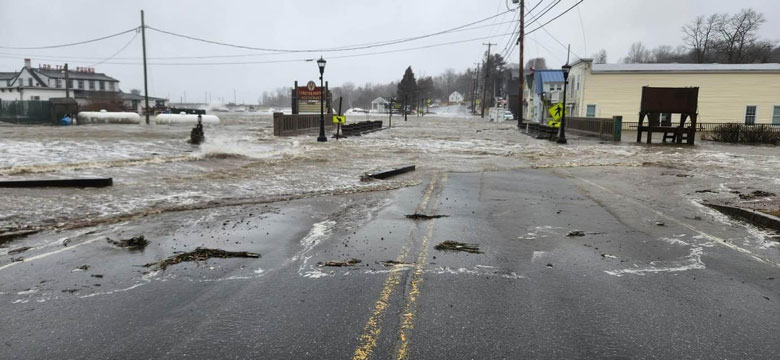“That’s the way it looks from here” was the jaunty sign-off of Lou McNally, Maine Public Radio’s long-time weather forecaster, and we knew a storm was coming. But king tides and climate change played another game.
On Jan. 13 the Maine coast was inundated. Water flowed into hundreds of towns, along the working waterfront. Businesses and roads were awash with water.
On Vinalhaven, the town’s parking lot had whitecaps as the storm moved through and the main street was impassible. On North Haven, Brown’s Boatyard, a century-old business, saw its pier and workshop damaged. Portland’s tide gauge read 14.57 feet, a new record.
In 1867 published a paper describing how the melting of ice in Antarctica could elevate sea levels.
There is no question that the sea level is rising. From Miami to Maine, stories of flooded streets, homes, and businesses come with each new tide. On the West Coast, multimillion-dollar houses teeter on cliff edge as storms erode the land beneath them.
Yet we look at these events in isolation. A flooded home, a shopkeeper throwing away damaged goods, and police directing traffic away from a flooded street. But seeing these events across the breadth of the East Coast suggests more—sinking coastlines, disrupted habitats, and rising seas.
Who first called attention to this problem? When did science begin to understand the concept that land could sink, glaciers melt, warming seas could rise, and contemplate the flooding that could occur?
Surprisingly, there is no single person who could be seen as the originator of the modern idea of sea level rise. It goes as far back as Archimedes who demonstrated water displacement, but it was in the 1800s that climate became part of the scientific discussion. And it was in the 1880s that the self-taught son of a Scottish farmer sat down and wrote his text on geography. While he did not specifically discuss rising sea levels he was an early contributor to the possibility of changing coastlines.
He was James Croll, whose amazing history produced an amazing man. He was born in poverty on a croft, a Scottish term for a small parcel of land on a large estate. When he was three, the lord told his family to leave, and they relocated to poor bottomland. Croll left school to work on the farm at 13.
At 16 he became a carpenter, a trade he pursued until an injury made it too painful to continue. He then held an astonishing number of jobs from insurance salesman to newspaper clerk, from temperance hotelier to tea salesman and tea merchant.
Through it all, as he wrote in his memoir, was “a strong and almost irresistible urge to study.” Without much formal schooling, he taught himself by reading Penny magazines, founded by the Society for the Diffusion of Useful Knowledge to provide education to the working poor.
Eventually, Croll found work as a janitor at a Glasgow museum. The museum was open a few hours each day so he had ample time to study, mastering physics, astronomy, and geology. He later recalled, “I have never been in any place so congenial to me as that institution.”
In 1864, this self-taught scientist began to publish in the most respected scientific journals of the times, contributing his thoughts on geology, tides, and the earth’s rotation. His notable paper: “On the physical cause of the change of climate during geological epochs” brought scientific recognition.
By 1875, his reputation had grown, and this son of a poor Scottish farmer without much formal schooling was inducted into the Royal Society of London and granted an honorary doctorate from St. Andrews. James Croll, a janitor, a genius, was very much like the Matt Damon character in Good Will Hunting.
But the story doesn’t end there. Sir Charles Lyell, head of the Geological Survey of Scotland, read his works and offered him a position as office secretary, since Croll couldn’t be given the appropriate title of geologist without formal education.
As secretary, he was the keeper of maps and surveys and continued to publish papers on ice ages, variations in the earth’s orbit, climate, glaciation, and ocean currents. In 1867 he published a paper describing how the melting of ice in Antarctica could elevate sea levels. Essentially, he was describing how sea levels might respond to melting ice sheets in a warming world, a century ahead of his time.
In 1965, almost 100 years after Croll, a team of scientists wrote to President Lyndon Johnson warning of the effects of climate change and the potential for sea level rise. And in 2022, scientists examining 2,000 years of global records determined that the significant changes in sea level began with the transition to fossil fuels at the dawn of the Industrial Revolution.
Finally, NOAA, also in 2022, released a detailed report predicting rises in sea levels on the East Coast of 10-13 inches by 2050.
Now we know that sea level rise is driven by a combination of factors associated with climate change. The ocean is warming, and warm water expands; there is water entering the sea from glacial melt, as well as the potential catastrophic melting of ice sheets. It was the rising seas combined with the January storm surge that overwhelmed Maine’s working waterfront.
Climate change is now a topic of daily discussion, with worldwide attention on the low-lying islands in the Pacific. In Maine as elsewhere on the East Coast, we have realized that it takes a community to work together to find solutions; solutions for Portland are different than solutions for Vinalhaven. Yet the problem is also one for all of us together.
The scale is enormous, the cost is high, and the effort needed can only be accomplished by recognizing time is short and by working together.
Steve Zoloth teaches public health at Northeastern University in Boston. He and his family spend summers on Vinalhaven.





